Lanark, UK, August 6th - 13th, 1910
Lots of flying and nice weather, but yet another financial failure...


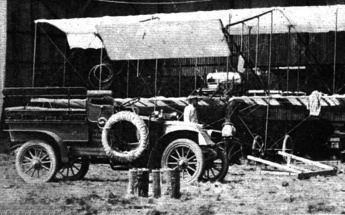


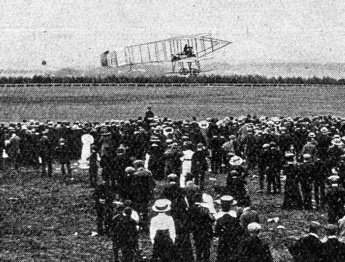

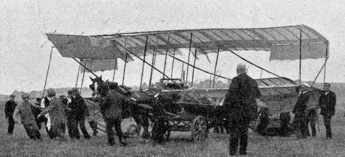

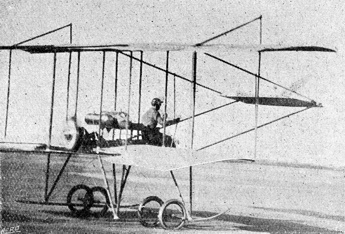




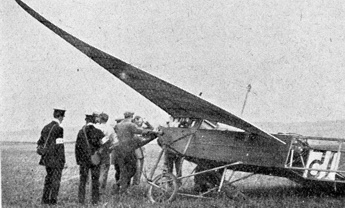


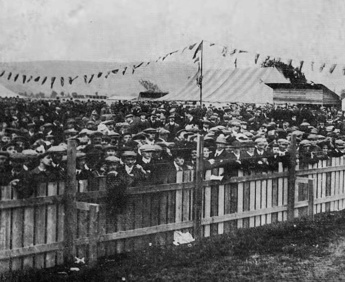

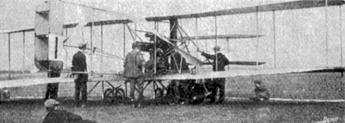





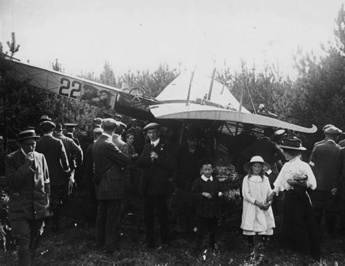
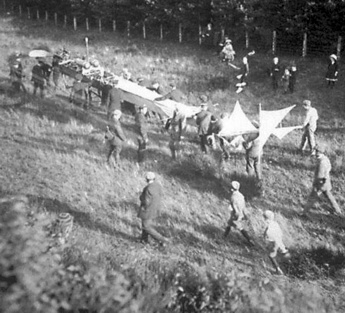
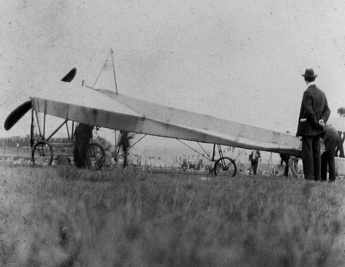



Lanark is a small town in the central belt of
Scotland, located around 45 kilometres southeast of
Glasgow, close to the river Clyde. It has been a market
town since medieval times and was originally the county
town of Lanarkshire, but lost that status to Glasgow in
1890. In 1910 it had around 7,000 inhabitants. There was
a couple of textile factories and tanneries, but
otherwise the town's economy relied on cattle trading
and fruit-growing. One of the attractions of the town is
the beautiful Clyde Falls south of the town.
The Fédération Aéronautique Internationale allotted two
international aviation meetings to Britain in 1910. The
first meeting was given to the Lancashire Aero Club and
Bournemouth. In February, the Scottish Aeronautical
Society made a bid to organize the second, at the Lanark
racecourse. The decision was taken in April, and
preparations started. An organizing committee was formed,
headed by the Duke of Argyll. It was decided to use the
racecourse for hangars and public enclosures, while a
flying course was laid out on the fields east of the
existing installations. The course was reached after a
starting straight of around one kilometre, which would
also be used for take-off contest and the "dispatch
carrying competition" in which the competitors
dropped "messages" on a target.
Lanark only had two hotels, and both were booked up far
in advance of the meeting. This wasn't a huge
disadvantage, since there were good train services from
Glasgow and from Edinburgh, both some 45 kilometres away.
The Caledonian Railway Company had built a temporary
station at the airfield, which they claimed could handle
30,000 passengers per day.
A company was registered, the "Scottish
International Aviation Meeting, 1910", and a
guarantee fund of £ 12,000 was collected. The total prize
money was set at £ 8,000. Messrs. Norman and McKnight of
Glasgow were contracted as official aeronautical and
repairing engineers, providing an up-to-date workshop
with machinery, a staff of trained builders and
mechanics, and a large selection of spare parts.
The meeting, which was the most important in Britain to
that date, attracted 22 entrants. With exception for
Claude Grahame-White, who was contracted to fly at the
coinciding Blackpool Flying Carnival, almost all
accomplished British flyers were present. The field also
included several experienced foreign flyers, for example
"Géo" Chávez, Marcel Hanriot, Bartolomeo
Cattaneo, Edmond Audemars, Gijs Küller and
"Edmond" (Edmond Morelle). The day before the
start of the meeting the machines of Chávez and Küller
were unfortunately destroyed by fire on the North-Western
Railway, close to Lancaster, on the way to the meeting.
Three more machines, the Hanriot of René Vidart, the
Tellier of Edmond Audemars and the Short of George
Colmore had gone missing on the railway and were delayed,
so the British railway operators had no reason to
celebrate. Maurice Tétard, who had entered, decided to
stay in Blackpool, where he probably had a guaranteed
purse.
Work at the airfield had progressed smoothly and
efficiently. Everything was ready in time, and the
quality of the hangars, which were solidly built and even
had corrugated metal roofs, was praised. Safety was
stressed in the regulations, which strongly decreed that
a competitor should only pass on the outside of the
competitor to be passed. The overtaking pilot was held
responsible for clearing the overtaken competitor and had
to keep at such a distance that the overtaken competitor
had undisturbed air in which to travel. In the interest
of safety, the announced precision landing contest was
cancelled. Official flights could take place between noon
and sunset.
Saturday 6 August
The first day of the meeting was windy and misty. Several
of the competitors were still busy assembling and
preparing their machines. Bertram Dickson was ready,
however, and made the first flight. He made a two-lap
flight of seven minutes, obviously troubled by the wind.
The reason for giving up the flight and landing was a
broken inlet valve, but he still returned to make a
perfect landing. The wind, which was measured to around 8
m/s during Dickson's flight, calmed down somewhat
during the afternoon and at half past three he was
followed by Cattaneo, and then by John Armstrong Drexel
and Gustave Blondeau. Drexel's total flying time was
1 hour 48 minutes, putting him far in the lead in the
endurance contests, while Cattaneo in his Gnôme-powered
Blériot took the lead in the speed contests. Late in the
evening Graham Gilmour took out his JAP-powered Blériot
and made a flight outside the airfield. After eleven
minutes it started raining and he was forced down.
Sunday 7 August
No official flights were scheduled during the Sunday, but
several pilots made test flights. One of them was
"Edmond" (Edmond Morelle), who tried out the
Farman copy built by the British and Colonial Aeroplane
Company of Bristol. His machine had been assembled by
French Farman mechanics, who weren't aware of the
differences between the original and the copy. As a
result, it was incorrectly rigged and flew with the
ailerons on one side permanently pulled down.
Monday 8 August
This was perfect day for flying. Already before the start
of official flights, "Edmond", whose machine
had now been re-rigged, and Florentin Champel made test
flights. The first two hours of official flying were
spent on the take-off contest. James Radley had borrowed
the Gnôme-engined Blériot of Launcelot Gibbs, who
couldn't participate for medical reasons. William
McArdle, Alec Ogilvie, and George Cockburn all made
successful efforts, while Audemars, who had fitted a
heavy in-line four-cylinder engine to his Demoiselle,
couldn't even lift off. It seemed like to big engine
didn't deliver power enough to lift itself off the
ground. Gilmour scored the day's best result, with
Radley second, while McArdle's best effort was
disqualified, since he had turned back on the ground and
crossed the start line a second time. He claimed that it
was not a proper effort, but the officials didn't
agree.
While the take-off contest went on, Dickson made an
effort for the cross-country contest. His time over the
36 kilometres was 36 minutes. After his landing, McArdle
also took off for the cross-country prize. When more than
an hour had passed, people started to worry that he had
had an accident. After a long time a telegram arrived,
explaining that he had flown at high altitude, lost sight
of the ground in the mist and failed to spot the turning
point. He had continued eastward almost to Edinburgh,
some 40 kilometres away for, the airfield, before turning
back to land near Corstorphine. He landed in a field,
without doing any damage, after spending 1 hour 25
minutes in the air. The machine had to dismantled and
sent back by road during the evening. It was also
announced that McArdle had lost his wallet, containing
the rather significant sum of £ 300, during the day.
After two o'clock, the endurance flying started.
Blondeau took off, but after a couple of laps he lost one
of his ailerons. The screws that held it had pulled out
of the wood. He managed to land safely by controlling the
plane with the rudder, but after touching down a hummock
caught the horizontal wire between the landing skids. The
skids were pulled together, which made the entire landing
gear collapse and put the plane on its nose, causing
considerable damage.
Then Dickson made an effort for the passenger prize, with
a reporter from "The Aero" on board. The
minimum weight of pilot and passenger was 25 stone (159
kg), but Dickson wanted to carry more than 180 kg, so he
added extra weight by wrapping lead sheet around the
landing gear legs. The added weight was probably too much
for the circumstances, and to make things even worse his
crew had miscalculated the weight and added 6 stone too
much. It was reported that the total load was 235 kg. The
plane lost lift at the third pylon when it was exposed to
the downdraught from the hills. Dickson managed to land
safely, but while still rolling the machine ran into a
ditch that hadn't been properly filled. The landing
gear on the left side was ripped off and both the upper
and the lower wings were destroyed. Dickson reportedly
"said rude things" about the man who had filled
the ditch with straw, rather than earth. Drexel also made
an effort for the passenger prize, but his engine
didn't pull well, and he gave up already on the first
straight.
There was an interesting and potentially lethal incident
in the hangar area, when Grace's engine was started.
One of the mechanics had left a knife on the ground,
which was sucked up by the propeller and thrown far away,
fortunately without hitting somebody. The knife knocked a
piece as large as the palm of hand out of the propeller
blade.
Chávez also borrowed Gibbs' Blériot to make an effort
at the altitude prize. Clouds were building up and at
1,500 metres he was lost from sight. He soon found it too
cold and wet in his light overcoat and returned to land.
He had carried two barographs, but they didn't agree.
One showed 1,500 metres and the other 1,800 metres, and
in the end his official result was given as 1,600 metres.
This was the last official flight, but again Gilmour made
the last flight, without official timing.
In total, seven pilots had entered the endurance contest.
Cattaneo was far ahead, having scored a total of more
than three hours in the air during the day, with Drexel
second and Champel third. Radley had taken over the lead
in the speed contests.
Tuesday 9 August
The weather was bright, but there was a nasty wind of
some 9 m/s from the north in the early afternoon. Chávez
announced that he would not take further part in the
flying because of difficulties finding a replacement
airplane, and that he would return to Paris. Küller was
busy building a machine from his spares, which had been
on a different train and hadn't been burned, and
parts that were sent from France. He had a complete spare
fuselage and a set of spare wings, but he didn't have
a spare landing gear. This unique piece of equipment was
particularly problematic and several parts of it had to
be built at the airfield. He also had to send for a
replacement engine, which couldn't be tested before
fitting.
Vidart was first in the air, around noon. The wind was
still manageable, and his handling of the Hanriot
monoplane, in his first appearance at an official
aviation meeting, impressed the crowds. Vidart's
flight was followed by the first efforts for the
"Dispatch Carrying Competition". The object of
this contest was to drop a "dispatch", in the
form of a ripe orange, as close as possible to a target
in the form of a red flag in the centre of a 12-foot
diameter sheet placed on the ground. Grace and Ogilvie
made efforts, with the former taking the lead by missing
the target by 7.26 metres, beating Ogilvie's 18.90.
Ogilvie had fitted his machine with a launching tube,
made from a biscuit tin, but one of his efforts still
failed when the orange hit a rigging wire and burst.
The wind then increased, and it went quiet for a long
while, until Cody brought out his machine. His big
machine was intended for a 100 hp engine that hadn't
been delivered, and was underpowered with an engine of
only 65 hp. It ran the length of the field and back,
barely getting off the ground.
At around six o'clock the wind calmed down. Drexel
was first to take advantage of the improved conditions,
going for the altitude prize. He kept climbing for a long
time and eventually reached 1,039 metres. He
"afforded a remarkable lunar spectacle" by
flying across the moon like a "small insect-like
shape, which was easily enclosed between the horns of the
crescent", according to the reporter from "The
Scotsman". He descended in a long glide, only
starting his engine once in a while. While Drexel was
still in the air Cattaneo and Grace also took off for the
altitude prize, but they only reached 987 and 756 metres
respectively. Afterwards, the airfield was rather busy,
with Vidart, Grace, Ogilvie and Cattaneo all competing
for the speed prize, while Edmond tried for the slow
flying prize. There was a bit of a traffic jam and
Cattaneo had to take evasive action above the crowds when
he came across Edmond.
Meanwhile, Radley made an effort for the cross-country
prize. He made the flight in 26 minutes, but got lost on
the way back. He wore goggles, which he wasn't used
to, because he had got oil in his eyes on a previous
flight, and was blinded by the setting sun in the haze.
This made him mistake the Lanark Loch, a little lake
northwest of the airfield, for a pond outside the
airfield that he had used as a landmark. After realizing
his mistake, he spotted the roofs of the hangars and came
down to land from the wrong direction, blowing a tyre
when touching down.
Later on, Vidart, Champel and Gilmour made test flights.
Just before closing time Edmond and Grace again tried for
the slowest lap prize. Edmond did best, stretching his
time to 3:31.6, corresponding to an average speed of
around 47.5 km/h.
Wednesday 10 August
The weather was perfect, and since it was an "early
closing day" in many neighbouring towns a lot of
people had the chance to go to the airfield. It was
estimated that there were more than 50,000 visitors.
Several pilots made tests during the morning. The Tellier
monoplane had finally arrived, and Audemars was eager to
test it, having retired and dismantled his re-engined
Demoiselle. His first one-lap flight was successful, but
after a second flight the plane swerved on the ground and
a wing touched the ground. The landing gear and a wheel
were damaged, which necessitated a few hours of repair
work. Edmond made a heavy landing during a passenger
flight and damaged his landing gear.
The day's first contest was the starting competition.
Radley made the best start, getting off in 32.6 metres,
while McArdle was second with 33,2 metres. Drexel tried
with a passenger on board and travelled 74 metres before
rising, while Grace, also with a passenger, needed 112
metres.
Early in the afternoon Cattaneo took off for the
endurance prize. He flew lap after lap and finally landed
after 3 h 11:41.6, having flown 227 kilometres. This was
announced as a British record, beating Louis
Paulhan's London-to-Lichfield flight for the
"Daily Mail" London-Manchester Prize. Later on,
Drexel and Cattaneo entered the altitude contest, but
both broke off their efforts after encountering strong
winds and turbulence that were set up by an approaching
thunder cloud. Several pilots made passenger flights,
among them Grace and Drexel. Drexel also made three long
flights, trying to close the gap to Cattaneo in the total
distance contest.
Cattaneo, Radley and Grace flew the five laps required
for the speed contest. Radley, who made two efforts,
scored best with a time of 9:32.4, beating Cattaneo by 21
seconds and Grace on his slower biplane by almost five
minutes. Radley also scored the day's fastest lap.
Around a quarter to six McArdle and Hanriot went for the
altitude prize. McArdle reached 698 metres, the best
result of the day. Champel's engine didn't run
well, and he failed to clear a rise in the ground during
a test flight. He touched down heavily, fortunately
without breaking anything, and managed to fly back to the
hangars. He was less lucky during a second flight. He
again made a slow take-off and flew a lap before running
wide at the turn and crashing in a fir plantation south
of the course. The engine didn't give enough power to
clear the trees, but he had the presence of mind to raise
the nose and slow the plane down to sink in an almost
vertical descent into the trees, where it came to rest
several feet off the ground. He escaped injury and the
plane was relatively lightly damaged, but some thirty
trees had to be felled in order to get it out.
Vidart and Grace also suffered minor mishaps.
Vidart's engine suddenly stopped on the course,
resulting in a broken landing gear, while Grace made
heavy landing, which resulted in a dented propeller and a
broken strut. Küller's Antoinette was finally close
to completion, but he had a narrow escape during the
evening, when a lamp ignited a fuel container. A brave
mechanic suffered a burned hand, but managed to throw the
container away outside the hangar.
Cattaneo's total distance stood at 624 kilometres at
the end of the day, leading Drexel by almost 130
kilometres.
Thursday 11 August
The weather looked promising in the morning - bright and
sunny with a little heat haze, but as noon approached the
wind increased, reaching 11 m/s in the gusts. During the
morning Edmond's crew made a test to measure the
thrust of his machine. The tail of the machine was tied
to a parked car outside the hangar, with the nose
pointing towards the hangar opening. When the engine was
opened up all kinds of stuff was sucked out of the hangar
and blown far away.
The only one who cared for flying was Küller, whose crew
had finally managed to build all the missing parts and
assemble his Antoinette. He took off around half past
twelve, after a short run against the wind. When he
passed the first pylon he got the gusty wind from the
side. The wings of the Antoinette had pronounced V-form,
which made it sensible to gusts from the sides, and he
was soon in trouble. The machine rocked violently from
side to side, the engine stopped and suddenly a wing tip
hit the ground, then the other. The landing gear skid dug
into the soft ground and the machine pitched onto its
nose and remained standing with the tail high in the air.
Küller was not injured, and he climbed out and dropped to
the ground while assistance arrived. The machine was
righted, and an inspection showed surprisingly small
damages. The propeller was shattered, the skid was
broken, and a tyre had blown, but thanks to the
Antoinette's wing tip leading edge skids the only
damage to the wings was a small tear in the fabric. The
loss of power had been caused by an ignition cable that
had come loose. The machine was towed back to the
hangars, where repairs immediately started.
At half past two Drexel came out and made an effort for
the speed contest. No great results could be expected
because of the wind, but he finished his five laps,
despite having to fight to remain in control. He made a
second effort an hour and a half later, but did not
manage to improve his result. Küller's repairs were
finished at half past four and he immediately rolled out
for a new start. He hit some bumps on the uneven ground
and the skid hit the ground when the landing gear
suspension compressed. It threw up a piece of turf that
was hit by the propeller, which was damaged. The machine
was returned to the hangars, where another replacement
propeller waited. Küller had ordered four, so there were
still two left.
Around six o'clock the wind calmed down and most
pilots made flights. Grace and Dickson went for the
cross-country prize and disappeared to the northeast,
followed by the faster Blériots of McArdle and Radley.
Cattaneo turned laps for the endurance contest, while
Ogilvie and Cockburn took off for the slow flight
contest, while Grace and Edmond went for the speed
contest. McArdle returned, pleased with finding the
turning point this time, followed by Radley, Grace and
Dickson, who had also managed to complete the course. The
efforts of McArdle and Radley were disallowed, however,
because they had landed short of the finish line, which
was crowded by other planes when they arrived. They were
not pleased with the decision and filed protests, to no
avail.
Shortly before seven o'clock Drexel and McArdle
announced that they would try for the altitude contest.
After being equipped with the necessary instruments they
took off and quickly climbed into the more and more
cloudy sky. Drexel's climbing turns took him further
and further to the north, and it became obvious that he
had lost his bearings. After almost half an hour he
disappeared out of sight into a cloud. It was not known
how much fuel he carried, and people at the airfield
started to worry when he didn't return within an
hour. McArdle returned from his effort, having reached
832 metres. Hanriot also made an altitude flight, but
gave up after reaching 411 metres. Küller made another
test at seven o'clock, but the engine failed after
three laps, and he landed out on the course. The last
flights of the day were a couple of passenger trips by
Edmond and Grace. Radley had scored best in the speed
contest, while Cockburn had taken the lead in the slow
flight contest. Work was going on in the hangars, where
Cody's crew had now fitted a second Green engine in
his machine. A Howard Wright machine with ENV engine had
arrived, having been on the way for eight or nine days on
the erratic British railways. It was reportedly intended
for Champel. Colmore's machine had also finally
arrived.
For a long time there was no news of Drexel. It was by
now obvious that he had come down somewhere, and cars
were sent out to search for him. At half past nine a
telegram finally arrived: "Have landed near
farmhouse at Wester Mossat, near Cobbinshaw Station. Am
now at Cobbinshaw Station. Please send mechanics to
station". After losing his way he had finally found
a field where he could land safely, some 16 kilometres
northeast of the airfield. He had borrowed a bicycle by
the surprised farmers, whose farm was actually named
Wester Mosshat, and ridden to the railway station, where
he could telegraph for help and was served tea by the
stationmaster. When he returned to the airfield, at half
past one in the night, he stated that he had landed after
some 50 minutes and still had quite a lot of fuel, but
that he was lost, his hands were completely numb from the
cold after passing through the big wet cloud without
gloves, and to make things worse he was starting to run
out of castor oil. He had decided to land as soon as he
found a good place, since he didn't want to risk the
engine stopping while trying to find his way back to the
airfield.
Friday 12 August
The sealed barograph that Drexel had carried was opened
and investigated by officials during the early morning,
before being sent to the Kew Observatory for checking. It
showed 2,057 metres (6,750 feet), a new world record. The
old record was held by Walter Brookins, who had reached
1,904 metres in a Wright at Atlantic City on July 10th.
The climb to the maximum altitude had only taken 34
minutes.
It had rained during the night, but the morning was
bright and windy. The wind speed reached 11 m/s around
noon, so nobody went for any longer flights. The first
event, the starting contest, began at one o'clock.
Because of the direction of the wind, it was decided to
make the take-offs towards the hangar area. This was
closer to the watching crowds, but it still didn't
arouse any great enthusiasm. It led to an exciting
incident, though, when McArdle's Blériot was pitched
upwards by a gust. He had to quickly decide whether to
try to climb above the hangars or land immediately. He
chose the latter option, but overcontrolled and made a
violent touchdown. The tail rose high in the air and for
a moment it looked like the machine would turn over on
its back, but it remained standing vertically on its
nose. The impact broke the landing gear and the
propeller. Radley, Dickson, Grace, Ogilvie and Edmond
also made efforts, some of them with passengers on board.
Radley scored the best result without passenger, 17.4
metres, while Ogilvie got off the ground in 45 metres
with a passenger.
The wind then increased, reaching 13-14 m/s, and the
airfield went quiet until four o'clock, when Küller
rolled out his Antoinette and pointed it into the wind.
He needed a long roll before leaving the ground, and it
looked like the engine didn't pull well. He turned
back onto the course and flew a lap, despite the wind,
but when he turned to start the second lap he suddenly
turned right and left the course. The machine lost speed
and crashed into the same fir plantation where Champel
crashed two days earlier. The young trees cushioned the
fall and reduced the damages, but the propeller, the
landing gear and the lower wing rigging were damaged.
Workmen immediately started felling trees in order to get
it out, but it took an hour and a half before a road had
been cleared and the disassembled machine could be
brought back. Küller, who was again unhurt, explained
that the main reason for the bad performance was that the
propeller, which was a replacement for the ones burned on
the train, didn't deliver enough thrust.
The wind continued to blow, and nothing happened until
half past five, when some of the machines were paraded in
front of the grandstands. Towards the evening the winds
calmed somewhat and at half past six Grace and Dickson
rolled out their planes. Grace was first to take off and
flew four laps. Dickson continued to fly after
Grace's landing and was soon followed by Drexel.
Drexel's flight of a little more than eight minutes
was the day's longest and ended a disappointing day
for the crowds.
Saturday 13 August
The morning was again bright, but windy. The wind speed
at noon was between 7 and 9 m/s - not comfortable for
flying, but not forbidding. The first one to fly was
Cody, who had removed one of the engines again, because
it had turned out to be impossible to synchronize the two
engines. It was not a glorious flight - he took off after
a roll of around 100 metres, flew in a straight line to
the end of the course, landed, turned the plane around
and flew back only a couple of metres above the ground.
He repeated the performance twice, each time with a
passenger on board. Several pilots had signalled the
intention to fly for different contest around the time
when Cody flew, but they called off their efforts when
the wind increased again, and the next flight wasn't
made until half past one. It was Grace, who made a
13-minute flight with a passenger on board. He was
followed by Hanriot, who made two short flights,
obviously troubled by the wind.
The next flights didn't take place until a quarter
past four, when the wind had come down to 6 m/s. Several
machines had entered for a novelty: The first
straight-line speed contest in the world. Seven
competitors had entered, and they were each allowed two
efforts. Radley was first, followed by Grace, Blondeau,
Dickson, McArdle, Cattaneo and Colmore, who now made his
first flight in the plane that finally had arrived and
been assembled. They made their second efforts in the
same order, but this time Colmore left the course and
crashed outside the field. He was not injured, but the
propeller and a wing were broken. The event was won by
Radley, who with the help of the tailwind covered the
one-mile course in 47.4 seconds, corresponding to a speed
of 122.2 km/h. This was around 17 km/h faster than the
world speed record, which was set by Léon Morane at Reims
a month earlier, but since Morane's speed was clocked
over a 10-kilometre closed course the results were of
course not comparable. There was also a one-kilometre
straight-line contest, which was timed during the same
flights but over only the last part of the course. The
ground was higher at the middle of the course, so the
mile course involved climbing while the planes could
descend slightly during the second half. Therefore, the
speeds over the kilometre were slightly better. Radley
won this contest too, with a speed of 125.0 km/h.
When the speed contest was finished McArdle, Grace and
Cattaneo started for the cross-country contest, in
perfect conditions. They all finished their flights
without problems, McArdle scoring the best time of the
week with 23:04.2. Then followed a very active period,
when there were sometimes six or seven machines in the
air at the same time - Drexel, Cattaneo, Radley, Ogilvie,
Dickson, Hanriot, Champel, Edmond and Cody, all competing
for different contests or carrying passengers. Grace made
the only successful flight for the weight-carrying
contest and managed to fly the required lap with a load
of 160.5 kilograms.
During the last minutes of the meeting there were a
couple of incidents. Radley's engine stopped at an
altitude of 180 metres and his machine was damaged during
the heavy forced landing. Grace had a more alarming
accident around eight o'clock, during the last flight
of the meeting. He was carrying a passenger, professor J.
Harvard Biles of Glasgow, when the propeller suddenly
disintegrated, throwing bits and pieces in all
directions. Several of them went through the rear part of
the wings, ripped the fabric, and made the ailerons
useless. The plane dropped, out of control. It made a
very heavy landing, and a tyre blew with a sound like a
pistol shot. The landing gear collapsed and the machine
crashed down on the lower wings. The crowd broke through
the fences and ran towards the accident site, and
ambulances arrived quickly, but fortunately there were no
injuries. After this there were no more flights.
Conclusion
From a sporting point of view, Drexel's altitude
record was the high point, but it was generally agreed
that this had been the most successful aviation meeting
in Britain. There had been no serious accidents and there
had been around three times as much flying as in
Bournemouth. Cattaneo had spent a total of 8 h 35:53.6 in
the air during the meeting, beating Drexel by around an
hour and a half. Grace had taken the biggest share of the
prize money, not because of any spectacular performances,
but he had performed solidly in all contests, in a
machine that he himself considered antiquated. Because of
that, he had won all the additional prizes that were
reserved for biplanes.
The officials, the practical arrangements of the meeting
and the behaviour of the crowds were also compared
favourably with the previous meetings. Ticket sales at
the gates totalled 144,344, with 31,724 on the best day,
which was the Wednesday. To this should be added around
10,000 "season ticket" holders each day.
350,000 words had been sent by telegraph from the
airfield by reporters from the press, and around 100,000
postcards had been handled at the airfield.
The Lanark Town Council decided that the Aviation
Committee had to compensate the 270 trees that had to be
cut down after Champel's and Küller's accidents
with the sum of £ 33 15 s, but this was only a small part
of the losses. The finances were, as at so many other
meetings, very disappointing. The meeting made a loss of
£ 8,750, which had to be paid by the guarantors, who had
in total committed £ 12,000. The reasons for the
disappointing finances of aviation meetings were
discussed in the aviation press. The conclusion was that
since they gathered so many spectators and so much
attention, the reason had to be overspending from the
organizers. Three factors were particularly identified:
Expensive construction of temporary grandstands and
hangars, expensive deals with landowners around the
airfields, and expensive deals with the flyers. It was
argued that participants shouldn't both be guaranteed
appearance money and offered big cash prizes for
different contests.

